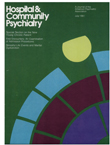An Aftercare Program for Problem Patients
Abstract
The high readmission rates of discharged psychiatric patients have forced mental health professionals to play closer attention to aftercare planning. A program was developed at a psychiatric hospital in Ontario in 1977 to deal with "problem patients"—those who were deemed difficult to place in the community by the referral person or department. The program was characterized by shared institutional-community staffing, systematic aftercare assessment and planning, a crisis intervention approach to discharge, the use of a transitional staff member with patients, and the development of close relationships with community agencies. Study data show that the program was effective in limiting the number of readmissions during its first two years to 20 per cent.
Access content
To read the fulltext, please use one of the options below to sign in or purchase access.- Personal login
- Institutional Login
- Sign in via OpenAthens
- Register for access
-
Please login/register if you wish to pair your device and check access availability.
Not a subscriber?
PsychiatryOnline subscription options offer access to the DSM-5 library, books, journals, CME, and patient resources. This all-in-one virtual library provides psychiatrists and mental health professionals with key resources for diagnosis, treatment, research, and professional development.
Need more help? PsychiatryOnline Customer Service may be reached by emailing [email protected] or by calling 800-368-5777 (in the U.S.) or 703-907-7322 (outside the U.S.).



